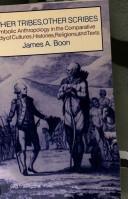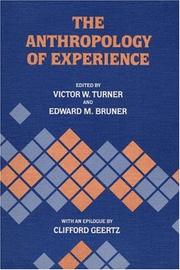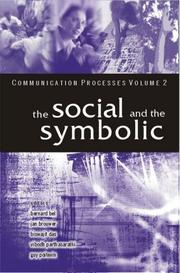| Listing 1 - 10 of 18 | << page >> |
Sort by
|
Book
ISBN: 9024750873 9789024750870 Year: 1971 Publisher: The Hague Nijhoff
Abstract | Keywords | Export | Availability | Bookmark
 Loading...
Loading...Choose an application
- Reference Manager
- EndNote
- RefWorks (Direct export to RefWorks)
Ricoeur, Paul --- Symbolic anthropology --- Ricœur, Paul --- Symbolism in anthropology --- Anthropology --- Lü-ko-erh --- Ricœur, P. --- Li-kʻo, Pao-lo --- ريكور، بول --- ريكور، پول --- Рикёр, Поль --- Rikër, Polʹ --- Ricœur, Paul. --- Ricœur, Jean Paul Gustave --- Ricœur, Paul, --- Ricœur, Paul, - 1913-2005
Book
ISBN: 9780822345923 9780822346104 0822346109 Year: 2010 Publisher: Durham, NC Duke University Press
Abstract | Keywords | Export | Availability | Bookmark
 Loading...
Loading...Choose an application
- Reference Manager
- EndNote
- RefWorks (Direct export to RefWorks)
"Making the case for a new kind of visual history, The Goddess and the Nation charts the pictorial life and career of Bharat Mata, 'Mother India', the Indian nation imagined as mother/goddess, embodiment of national territory, and unifying symbol for the country's diverse communities. Soon after Mother India's emergence in the late nineteenth century, artists, both famous and amateur, began to picture her in various media, incorporating the map of India into her visual persona. The images they produced enabled patriotic men and women in a heterogeneous population to collectively visualize India, affectively identify with it, and even become willing to surrender their lives for it. Filled with illustrations, including 100 in color, The Goddess and the Nation draws on visual studies, gender studies, and the history of cartography to offer a rigorous analysis of Mother India's appearance in painting, print, poster art, and pictures from the late nineteenth century to the present. By exploring the mutual entanglement of the scientifically mapped image of India and a (Hindu) mother/goddess, Sumathi Ramaswamy reveals Mother India as a figure who relies on the British colonial mapped image of her dominion to distinguish her from the other goddesses of India, and to guarantee her novel status as embodiment, sign, and symbol of national territory. Providing an exemplary critique of ideologies of gender and the science of cartography, Ramaswamy demonstrates that images do not merely reflect history; they actively make it."--Back cover.
Group identity --- Mother goddesses --- Postcolonialism --- Symbolic anthropology --- Political aspects --- Symbolism in anthropology --- Post-colonialism --- Postcolonial theory --- Collective identity --- Community identity --- Cultural identity --- Social identity --- Goddesses --- Identity (Psychology) --- Social psychology --- Collective memory --- Anthropology --- Political science --- Decolonization

ISBN: 0521271975 0521250811 Year: 1982 Publisher: Cambridge Cambridge University press
Abstract | Keywords | Export | Availability | Bookmark
 Loading...
Loading...Choose an application
- Reference Manager
- EndNote
- RefWorks (Direct export to RefWorks)
Ethnology. Cultural anthropology --- Symbolic anthropology. --- Ethnology --- Methodology. --- Philosophy. --- Symbolism --- Anthropologie sociale et culturelle --- Symbolisme --- Philosophy --- Methodology --- Philosophie --- Méthodologie --- Symbolic anthropology --- #SBIB:39A3 --- Symbolism in anthropology --- Antropologie: geschiedenis, theorie, wetenschap (incl. grondleggers van de antropologie als wetenschap) --- Anthropology
Multi
ISBN: 9781107025691 9781107651098 9781139198707 9781139518994 1139518992 1280775203 9781280775208 9781139517133 1139517139 1107025699 1107651093 1107232147 1139508385 9786613685599 1139518062 1139515489 113919870X 1139514563 Year: 2012 Publisher: Cambridge Cambridge University Press
Abstract | Keywords | Export | Availability | Bookmark
 Loading...
Loading...Choose an application
- Reference Manager
- EndNote
- RefWorks (Direct export to RefWorks)
Symbolic thought is what makes us human. Claude Lévi-Strauss stated that we can never know the genesis of symbolic thought, but in this powerful new study Alan Barnard argues that we can. Continuing the line of analysis initiated in Social Anthropology and Human Origins (Cambridge University Press, 2011), Genesis of Symbolic Thought applies ideas from social anthropology, old and new, to understand some of the areas also being explored in fields as diverse as archaeology, linguistics, genetics and neuroscience. Barnard aims to answer questions including: when and why did language come into being? What was the earliest religion? And what form did social organization take before humanity dispersed from the African continent? Rejecting the notion of hunter-gatherers as 'primitive', Barnard hails the great sophistication of the complex means of their linguistic and symbolic expression and places the possible origin of symbolic thought at as early as 130,000 years ago.
Linguistics --- Ethnology. Cultural anthropology --- Symbolic anthropology. --- Language and languages --- Human evolution. --- Thought and thinking. --- Origin. --- Symbolic anthropology --- Human evolution --- Thought and thinking --- Origin --- Mind --- Thinking --- Thoughts --- Educational psychology --- Philosophy --- Psychology --- Intellect --- Logic --- Perception --- Psycholinguistics --- Self --- Evolution (Biology) --- Physical anthropology --- Evolutionary psychology --- Human beings --- Origin of languages --- Speech --- Symbolism in anthropology --- Anthropology --- Social Sciences --- Language and languages - Origin

ISBN: 0252012364 0252012496 Year: 1986 Publisher: Urbana, Ill.
Abstract | Keywords | Export | Availability | Bookmark
 Loading...
Loading...Choose an application
- Reference Manager
- EndNote
- RefWorks (Direct export to RefWorks)
Ethnology. Cultural anthropology --- Ethnology --- Experience --- Humanities --- Anthropologie sociale et culturelle --- Expérience --- Sciences humaines --- Methodology --- Philosophy --- Méthodologie --- Philosophie --- #SBIB:39A5 --- #SBIB:39A4 --- Kunst, habitat, materiële cultuur en ontspanning --- Toegepaste antropologie --- Experience. --- Symbolic anthropology. --- Methodology. --- Philosophy. --- Expérience --- Méthodologie --- Symbolic anthropology --- Symbolism in anthropology --- Anthropology --- Knowledge, Theory of --- Psychology --- Reality --- Pragmatism --- Humanities Methodology
Book
ISBN: 9155427936 Year: 1991 Publisher: Stockholm Almqvist och Wiksell International
Abstract | Keywords | Export | Availability | Bookmark
 Loading...
Loading...Choose an application
- Reference Manager
- EndNote
- RefWorks (Direct export to RefWorks)
Ethnophilosophy --- Folk models --- Symbolic anthropology --- Ethnophilosophie --- #SBIB:39A71 --- #SBIB:39A73 --- Symbolism in anthropology --- Folk philosophy --- Indigenous peoples --- Philosophy, Primitive --- Primitive philosophy --- Etnografie: comparatieve studies --- Etnografie: Afrika --- Philosophy --- Conferences - Meetings --- Anthropology --- Ethnology --- Cognition and culture --- Methodology --- Cosmologie --- Langage symbolique --- Corps humain --- Ethnologie --- Anthropologie culturelle --- Afrique noire --- Afrique
Book
ISSN: 17612160 ISBN: 9782728804269 2728804265 Year: 2009 Publisher: Paris Editions de l'Ecole normale supérieure
Abstract | Keywords | Export | Availability | Bookmark
 Loading...
Loading...Choose an application
- Reference Manager
- EndNote
- RefWorks (Direct export to RefWorks)
Quels sont les processus de transformation d’une forme symbolique ? Comment s’importe-t-elle et s’intègre-t-elle dans des traditions et des rituels qui lui sont étrangers ? Pierre Déléage nous livre ici une belle étude de cas. Son enquête, à la croisée de l’anthropologie et de l’histoire, a pour terrain les relations qui s’établirent, au cours des XVIIe et XVIIIe siècles, entre des missionnaires catholiques et les Micmacs, groupe amérindien peuplant les côtes atlantiques de l’actuelle frontière séparant le Canada des États-Unis. Chez les Micmacs, la croix était un signe d’alliance diplomatique, guerrier et chamanique. Confrontés à cette situation, les missionnaires français usent d’un syncrétisme pédagogique pour propager la croix chrétienne. Quant aux " hiéroglyphes" micmacs, méthode d’inscription tout à fait exceptionnelle, ils se constituent à l’intersection des traditions pictographiques autochtones et de l’écriture alphabétique apportée par les missions. Cet ouvrage démontre la force d’innovation produite par les interactions entre des systèmes symboliques différents. Il décrit et explique comment l’hétérogénéité culturelle construit l’efficace des objets et des rituels, assure leur propagation et aboutit à l’invention de traditions nouvelles pour un groupe humain donné à un moment de son histoire
Missionaries --- Symbolic anthropology --- North America --- Crosses --- New France --- Micmac Indians --- Micmac language --- Symbolism in anthropology --- Anthropology --- Religious adherents --- Micmaensi language --- Micmak language --- Mihemak language --- Mikmaque language --- Mi'kmaq language --- Algonquian languages --- Mickmak Indians --- Migmac Indians --- Mi'kmaq Indians --- Mi'kmaw Indians --- Algonquian Indians --- Indians of North America --- Calvaries --- Crucifixes --- Roods --- Signs and symbols --- Crucifixion --- Rites and ceremonies --- Writing --- History --- North America - New France

ISBN: 8132112490 1282004433 9786612004438 8132101170 9788132101178 9780761934462 0761934464 9788178295893 817829589X 9352803345 Year: 2007 Publisher: New Delhi Thousand Oaks, Calif. SAGE Publications
Abstract | Keywords | Export | Availability | Bookmark
 Loading...
Loading...Choose an application
- Reference Manager
- EndNote
- RefWorks (Direct export to RefWorks)
Arguing that communication, an exchange of symbols, is the essence of society, this work highlights the links between culture studies and the use of communication in binding together a community and providing a voice to the unheard and unsung.
Cognition and culture --- Communication and culture --- Ethnopsychology --- Symbolic anthropology --- Indic literature --- Symbolism in anthropology --- Anthropology --- Cross-cultural psychology --- Ethnic groups --- Ethnic psychology --- Folk-psychology --- Indigenous peoples --- National psychology --- Psychological anthropology --- Psychology, Cross-cultural --- Psychology, Ethnic --- Psychology, National --- Psychology, Racial --- Race psychology --- Psychology --- National characteristics --- Culture and communication --- Culture --- Culture and cognition --- Cognition --- Ethnophilosophy --- Socialization --- History and criticism. --- India --- Social life and customs.
Book
ISBN: 0631161201 Year: 1975 Publisher: Oxford Blackwell
Abstract | Keywords | Export | Availability | Bookmark
 Loading...
Loading...Choose an application
- Reference Manager
- EndNote
- RefWorks (Direct export to RefWorks)
Social change --- Symbolism --- Social structure --- Symbolisme --- Changement social --- Structure sociale --- Symbolic anthropology --- 316.77 --- #SBIB:39A3 --- #SBIB:309H504 --- 316.32 --- Organization, Social --- Social organization --- Anthropology --- Sociology --- Social institutions --- Change, Social --- Cultural change --- Cultural transformation --- Societal change --- Socio-cultural change --- Social history --- Social evolution --- Communicatiesociologie --- Antropologie: geschiedenis, theorie, wetenschap (incl. grondleggers van de antropologie als wetenschap) --- Code en boodschap: sociologische, antropologische benadering --- Globale samenlevingsvormen --- Social change. --- Social structure. --- Symbolic anthropology. --- 316.32 Globale samenlevingsvormen --- 316.77 Communicatiesociologie --- Symbolism in anthropology
Book
ISBN: 0231040326 0231040334 Year: 1977 Publisher: New York Columbia university press
Abstract | Keywords | Export | Availability | Bookmark
 Loading...
Loading...Choose an application
- Reference Manager
- EndNote
- RefWorks (Direct export to RefWorks)
Ethnology --- Symbolism --- Anthropologie sociale et culturelle --- Symbolisme --- #SBIB:39A3 --- 291.37 --- 39 <082.2> --- Symbolic anthropology --- Symbolism in anthropology --- Anthropology --- Antropologie: geschiedenis, theorie, wetenschap (incl. grondleggers van de antropologie als wetenschap) --- Processies. Symbolen. Riten. Emblemen --- Volkenkunde. Zeden en gebruiken. Culturele antropologie--Bloemlezingen. Readers. Citaten --- Symbolic anthropology. --- 39 <082.2> Volkenkunde. Zeden en gebruiken. Culturele antropologie--Bloemlezingen. Readers. Citaten --- 291.37 Godsdienstige ceremonieën. Religieuze symboliek. Mysteries. Inwijding --- 291.37 Processies. Symbolen. Riten. Emblemen --- Godsdienstige ceremonieën. Religieuze symboliek. Mysteries. Inwijding
| Listing 1 - 10 of 18 | << page >> |
Sort by
|

 Search
Search Feedback
Feedback About UniCat
About UniCat  Help
Help News
News